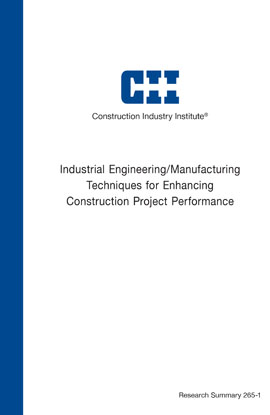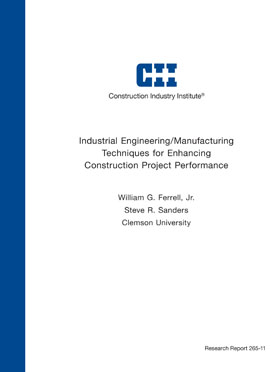
Industrial Engineering/Manufacturing Techniques for Enhancing Construction Project Performance
This document summarizes the efforts of CII Research Team (RT) 265, Industrial Engineering/Manufacturing Techniques for Enhancing Construction Project Performance, to investigate the applicability of well-known industrial engineering (IE) techniques to common problems in field project operations. The team isolated and adapted a number of techniques that allow construction site personnel to solve problems by identifying and deploying the appropriate IE techniques.
Although the mention of IE usually evokes images of time and motion studies, modern industrial engineering offers a broad collection of tools and techniques that can be adapted to everyday construction site situations. These time-tested methods represent solid commonsense solutions to the problems that create non-value added (NVA) time spent on construction sites everywhere. Previous CII research has determined that NVA activities consume between 50 and 75 percent of the available time on a jobsite. This persistent drain on productivity provided the impetus for establishing RT265 to identify any industrial engineering techniques that will minimize NVA activities on jobsites.
RT265 was composed of IE and design-build subject matter experts from owner and contractor organizations. During the research process, members of both groups contributed their expertise to help determine which IE techniques to adapt. They did this by systematically assessing the problems typically encountered on construction sites and matching them to the IE techniques under study. The team adapted and modified these basic techniques for field project operations. The intent was to make them usable by superintendents, warehousemen, and craft foremen, as well as by project managers and planners who are responsible for assembling and managing the resources for construction projects regardless of size.
The researchers first made a series of project site visits to interview superintendents, foremen, and project managers, to get their input on what they needed in terms of industrial engineering tools and techniques. The research team then used this input to develop a software tool on a dot-Net platform that was envisioned as a handy onsite source of IE advice. While this resource was ultimately not produced, the information presented in the tool is accessible in Research Report 265-11, Industrial Engineering/Manufacturing Techniques for Enhancing Construction Project Performance.
Previous research isolated five significant factors contributing to non-value adding (NVA) activities. (RS265-1, p. 3)
- Incorrect materials
- Inadequate equipment
- Lack of appropriate tools
- Absence of information
- Insufficiently qualified personnel
(RS265-1, p. 29)
RS265-1, IE Techniques for Construction Jobsites
Shows the benefits of using 22 IE techniques to improve jobsite problems. (RS265-1, Appendix, p. 31)


